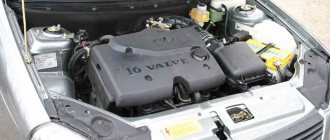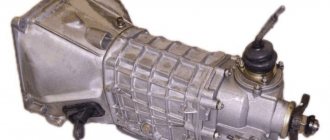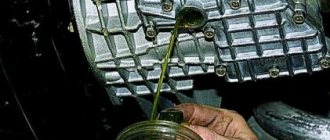Changing the oil and filter in the engine is a mandatory operation according to the maintenance regulations. The manufacturer specifies the service interval based on mileage or time from the date of sale of the vehicle. But these are calculated data that do not take into account the operating features of the machine. Let's figure out when you need to change the lubricant and how to do it correctly so as not to end up with a premature overhaul.
Why do you need to change the oil?
Each engine is equipped with a lubrication system to supply oil to the rubbing parts. The oil leaves a film on the surface that protects parts from dry friction and increases the wear resistance of the unit. Over time, the oil layer becomes thinner. The rate of film destruction is influenced by various factors:
- metal properties;
- surface roughness;
- load;
- speed of movement of parts;
- temperature;
- initial film thickness and its composition.
In addition to creating a protective film, auto lubricant performs other functions:
- Cools parts.
- Removes carbon deposits and wear products.
- Protects against corrosion.
For normal operation of the mechanisms, it is necessary to supply a sufficient amount of lubricant to create the maximum load-bearing capacity of the oil layer and prevent overheating of the surface. The greatest load comes on the crankshaft bearings, and the connecting rod and piston group operates at high temperatures. Prolonged heating above 120℃ leads to aging of the oil composition. It oxidizes from contact with unburned fuel and crankcase gases. Quickly becomes contaminated with wear products.
Periodic replacement of engine oil allows you to maintain the working properties of the lubricant and prevent premature engine overhaul. The manufacturer indicates the scheduled time frame for when it is time to change the oil in the car. But in practice, in order to preserve the life of the motor, you need to learn how to determine the frequency of replacement yourself.
Results of experiments with oils
Specialists from the famous automobile magazine “Behind the Wheel” conducted six-month studies of several types of synthetic oils under operating conditions in city traffic jams (at idle speed). To do this, the engines operated for 120 hours (the equivalent of 10 thousand kilometers on the highway) at 800 rpm without cooling. As a result, interesting facts were obtained...
First, the viscosity of all motor oils during prolonged idling up to a certain (critical) moment is significantly less than when driving “on the highway”. This occurs due to the fact that at idle speed, exhaust gases and unburnt fuel leak into the engine crankcase, where it is all mixed with oil. In this case, there may be some (insignificant) amounts of oil in the fuel.
The drop in viscosity of motor oil is about 0.4...0.6 cSt (centistokes). This value is within 5...6% of the average level. That is, the viscosity is within normal limits. However, this only happens up to a certain point.
Clean and used motor oils
At approximately 70...100 engine hours (each oil is different, but the trend is the same for all), the viscosity begins to increase sharply. And much faster than when working in the “track” mode. The reasons for this are as follows. The oil is constantly in contact with the products of incomplete combustion (as discussed above), and reaches its critical saturation.
The mentioned products have a certain acidity, which is transferred to the oil. Also affected is the lack of ventilation and low turbulence of the air-fuel mixture due to the fact that the piston moves relatively slowly. Because of this, the rate of fuel combustion is lower than average, and the entry of exhaust gases into the crankcase is maximum.
The widespread belief that a large amount of dirt forms in the engine when idling has not been experimentally confirmed. However, the amount of high-temperature deposits was small, and the amount of low-temperature deposits was large.
As for wear products, their amount is significantly greater in oil used in the “plug” mode than in the one that was used on the “highway”. The reason for this is the low speed of the pistons, as well as the high operating temperature of the oil (lack of ventilation). As for waste, each oil behaves differently. However, it can be argued that due to high operating temperatures and increased density, waste will also increase.
Based on the information provided, we will try to systematize the data and answer the question of how many kilometers to change the engine oil.
Oil change intervals
If you ask drivers when they plan to change the engine oil, the most popular answers are: during maintenance, with the onset of winter, after 12 months, etc. Dealers, as a rule, recommend changing the lubricant after 10 - 15,000 km. But what is the reason for this mileage?
The oil can last almost forever under ideal operating conditions: a clean engine, leisurely driving without overheating and high loads. Rough driving around the city, various climatic conditions, off-road conditions, and towing trailers greatly reduce the service life of engine lubricant.
In addition to operating conditions, the replacement period is affected by the quality of the product, age and mileage of the vehicle. With old age come diseases that cause oil burns: leaks through oil seals, cylinder head gasket or oil filter, oil seals, worn piston rings and cylinders. To avoid oil starvation, it is necessary to check the lubrication level at least once a month.
The replacement interval is determined by mileage or engine hours. Some lubricants retain their operating properties over 200 m/h, while others can withstand up to 350 m/h. To determine how long the engine has worked, install special sensors or calculate the replacement interval based on the average speed:
Mileage = M/h * Average speed
For example, let’s take a synthetic auto lubricant designed for 300 m/h, and the average vehicle speed in the city is 25 km/h. The composition will need to be replaced after 300*25 = 7,500 km. While a country resident driving at a speed of 50 km/h will have to make a replacement less often - after 15,000 km.
After changing the engine oil, the speed indicator is reset to zero.
It is necessary to monitor the oil level
The quality of the composition will also indicate the need to replace the motor lubricant when checking the level. If the oil begins to thicken, lose transparency or burn quickly, it’s time to change it. To check the lubrication, a dipstick is provided in the engine.
Similar article What oil to pour into a 1NZ FE engine
How to check the level:
- Park the car on a level surface.
- Warm up the engine and turn it off so that the lubricant has time to drain into the pan.
- Remove the dipstick and wipe it with a clean cloth.
- Insert the dipstick back as far as it will go.
- Take out the dipstick again and evaluate the oil level on the scale: the norm is between the extreme marks.
A lack of lubrication in the crankcase leads to its rapid aging and ineffective operation of the lubrication system, i.e. oil starvation of the engine. The composition must be added to the engine through the oil filler neck located on the cylinder block. The neck is closed with a cap with the inscription Oil Fill or viscosity marking. Oil should be poured in portions of no more than 200 - 300 ml at a time.
Excess is just as harmful as not enough. Excess lubricant is squeezed out through gaskets and seals, which leads to engine contamination and additional load on the crankshaft.
What kind of oil to pour into the engine
In the operating instructions, the manufacturer always indicates which oil should be poured into the engine. For example, for a VW CZCA 1.4 l TSI engine, a composition with a VW 508.00 or 502.00 approval is suitable, and for a VAZ 21129 - with a viscosity of 5W-30 and 10W-40. Don't ignore the recommendations. When developing a specific motor, engineers determine the quality requirements for auto lubrication based on the design, permissible loads and thermal calculations.
Motor oils have to work in difficult conditions, so they are subject to stringent requirements, sometimes contradictory to each other. The composition should not be too thick so as not to create resistance to the parts. But a too fluid state will not allow you to obtain a durable protective film.
Motor oils are characterized by viscosity, which changes depending on temperature. When heated, the lubricant becomes more liquid, and when it cools, it thickens. The degree of “liquefaction” is determined by the viscosity index. The higher it is, the less the viscosity of the composition changes.
Motor oils are based on mineral or synthetic components with a large number of additives. The mixture is selected in such a way as to ensure the specified physical and chemical properties. Additives improve the quality of oils in certain areas:
- anti-wear and extreme pressure;
- anti-corrosion;
- affecting film hardness;
- anti-foam, etc.
Since each type of motor oil has a unique composition, different lubricants cannot be mixed. When the engine oil level drops, you need to add exactly the same amount that was previously filled. If it is not known to be flooded, it is better to completely replace the oil and filter.
Changing the engine oil
Changing the engine oil is perhaps the most common service at any car service center. It seemed that it could be simpler: unscrew the plug, drain the oil, replace the filter, pour in new engine oil and that’s it... Some services even offer this service for free.
Let's look at this procedure step by step:
- Selection of engine oil and filter, and consumables
- General recommendations
- Removing the old oil filter
- Draining old engine oil
- Selecting oil and filter
- Installing a new oil filter
- Filling in new engine oil and checking its level
- Resetting the service interval on the instrument panel and installing a reminder tag under the hood
Selection of engine oil, filter, and consumables.
Before the craftsmen get down to business, it is worth deciding on the source materials.
Filters. There is an opinion that the filter is a simple part and it is not worth overpaying for it. Actually this is not true. The most important parameters are the quality of the filter material and its area. Manufacturers of cheap filters save money on this.
We use filters from the best manufacturers: KNECHT, MAN, FILTRON DENSO. The products of these companies are delivered to the conveyor belt. A wide range of products is always available in our warehouse.
Engine oil. The oil market is incredibly huge. Every seller will praise the oil from his display case. In this matter, the main thing is not to buy a fake and choose the right oil for your car. Nowadays, each automaker determines the requirements for motor oil in the form of tolerances. It is very important that the oil you purchase meets these tolerances. Otherwise, even very expensive oil may disappoint you.
Consumables. In addition to engine oil and a filter, you will need: an o-ring for the drain plug, and sometimes the plug itself.
General recommendations.
It is better to change the oil on a warm engine; hot oil has a lower viscosity and drains better from engine parts. The car must be on a horizontal surface, otherwise not all the oil will drain from the engine, and it will be impossible to control its level when filling.
Removing the oil filter.
Why is it important to start with this operation? The fact is that when you remove the oil filter, oil begins to drain from the oil channels. This ensures a more complete removal of old motor oil from the engine.
To unscrew the old filter, the technician will need a special tool. Each filter has its own unique key. In a good service they are sure to be present. Of course, there are universal pullers, but professionals do not use them, because such methods often crush the filter or completely destroy it.
Draining engine oil.
The main goal of this stage is to drain as much old oil as possible. As you understand, it is impossible to remove absolutely all the oil from the engine. A certain amount will remain in the oil channels, hydraulic compensators, and some engine cavities.
There are two main ways. Drain the engine oil through the drain hole in the engine crankcase or use a special vacuum unit to pull the oil through the filler neck. The second method is used when it is not possible to drain the oil through the drain plug. This usually happens when there is no free lift at the service station or when access to the drain hole is limited. For example, there is additional crankcase protection or the plug was “licked” by previous “specialists”.
In the vast majority of cases, we drain the old engine oil through the drain hole. We consider this method the most effective.
One more nuance. On some vehicles, the engine has two drain holes. For example PORCHE CAYENNE 4.5. If your mechanic does not know this, then there is a chance of getting into a very unpleasant situation.
Unscrewing the oil drain plug often brings its own surprises. A tightly tightened plug, “licked” edges, or completely broken threads in the pan. All this is usually after visiting cheap services. If you don’t want to go shopping looking for a cork, we recommend using the services of a service that has consumables in stock.
When installing the oil drain plug, the sealing washer is always replaced with a new one. And the plug itself is tightened with the force specified in the operating instructions. This guarantees complete tightness and no problems at the next oil change.
Installing the oil filter.
The filter packaging usually contains detailed instructions for installing it. Good filter manufacturers always include accompanying O-rings. It is important to clean the contact surface and lubricate the rubber seals with oil before installing the filter. Otherwise, they may be damaged during installation. The second important point is the tightening force. As a rule, it is not large. Often, technicians over-tighten the filter, which leads to problems during the next oil change, and sometimes even damage to the filter.
Refueling volumes
Before changing the engine oil, you need to find out how much lubricant you need to buy. This information is provided in the machine manual. The filling volume depends on the configuration of the power unit and the replacement method.
So when changing the oil, engine 21129 needs to be filled with:
| Equipment | Without filter replacement, l | With filter replacement, l |
| With manual transmission | 3,2 | 2,9 |
| With manual transmission | 4,4 | 4,1 |
A GAZelle with the ZMZ 405 internal combustion engine will require 6.0 liters, while when equipped with the UMZ 4216 - 5.8 liters. The filling volume of KamAZ-65115 with engine 740.622-280 accommodates 28 liters of “motor”.
Similar article Setting timing marks for Priora engine 16 valves VAZ 21126
What do you need to know before changing engine oil?
Changing the engine mixture is a prerequisite for operating the power unit; thanks to the use of good quality oil, the possibility of formation of carbon deposits and sludge on the drive elements can be eliminated. The main reason for their formation is the processes that lead to the aging of oils - the oxidation reaction of hydrocarbons included in the base of motor oil.
We recommend: Design and principle of operation of the ABS system
If the car is new and its owner uses motor fluid recommended by the vehicle dealer and performs scheduled oil changes on time, then the formation of deposits on engine elements is excluded: modern oils have detergent additives in their structure that prevent the formation of deposits. Owners of new cars in which the drive has completed less than half of its service life should be guided by the following rules when replacing engine fluid:
- You cannot skimp on the quality of your motor oil. A synthetic base is the optimal solution; it practically does not change the viscosity-technological indicators at different temperature conditions.
- Mineral oil is changed after 7-8 thousand mileage after a scheduled replacement of the engine mixture, semi-synthetics must be replaced after 10 thousand km, synthetics can be changed at 15 thousand km. But keep in mind that these recommendations are indicated for European roads, where the vehicle’s operating conditions are close to ideal. In our case, it is better not to reach the recommended mileage and carry out a scheduled replacement earlier than the specified interval.
- If you adhere to an extreme driving style, or are often stuck in traffic jams, keep in mind that these factors negatively affect the engine mixture. When heated, the liquid dilutes, its protective properties deteriorate, so if you want to be first at traffic lights, then buy high-quality synthetic-based products.
- Before changing engine oil, consider the temperature outside the vehicle; it is important that the fluid has a viscosity that can protect the engine from wear at the maximum low and high temperatures in your region.
The situation is more complicated when changing engine oil in a used car; before changing the engine fluid, take into account what mixture was used before. You should not exchange mineral water for synthetics: synthetic mixtures have increased cleaning properties and, on a heavily polluted engine, can break down deposits without completely dissolving them. This will lead to separation of the split mass from the surface of the drive elements and cause clogging of the channels of the lubrication system and internal combustion engine. A heavily contaminated engine must be properly flushed before changing the oil.
Replacing the oil filter
When changing engine oil, do not forget to install a new filter. It cleans the oil flow from solid particles of worn engine parts, carbon deposits, etc. The filter element is made of paper, cardboard, or synthetics. Filters are divided into full-flow, if all the oil passes through them, and part-flow, if the lubricant partially passes through.
The more dirty the filter is, the worse its throughput. A bypass valve is installed inside the filter, which prevents pressure drop in the line. At a certain pressure, the valve opens and lubricant flows into the motor, bypassing the filter. Prolonged operation of the engine on dirty oil leads to clogging of the lubrication system and wear of parts.
Passenger cars are equipped with full-flow replaceable filters. In trucks, two elements are often used: full-flow with a replaceable filter and part-flow centrifugal.
Why do you need regular oil changes?
Indication on the dashboard
What can happen to a car if you don’t change the engine oil for a long time? To answer this question, you need to understand what functions it performs. Any oil consists of a so-called “base” and a certain amount of additives. They are the ones who protect engine parts.
During the operation of the machine, and even its parking, continuous chemical destruction of additives occurs. Naturally, this process is faster when driving. In this case, natural deposits form on the engine crankcase, oxidation processes occur with individual components of the oil, its viscosity and even the pH acidity level change. These facts are the answers to the question - why change the oil once a year at least.
Some automakers and motor oil manufacturers indicate how long it takes to change the engine oil not by mileage, but by frequency, usually by month.
And under significant load, the described processes in the oil occur at an even greater speed. Especially at high temperatures. However, modern manufacturers are constantly improving the technologies and chemical compositions of their oils. Therefore, they are able to withstand pollution and high temperatures for a long time.
In many modern cars, the ECU constantly monitors when to change the engine oil. Naturally, this decision is made on the basis of empirical methodology. It is based on actual data - average engine speed, oil and engine temperature, number of cold starts, speed limit, and so on.
Unfortunately, on store shelves not only in the Russian Federation, but also in other CIS countries, a large number of low-quality or simply counterfeit motor oils are currently sold. And given that our fuel is often of poor quality, the frequency of oil changes still needs to be adjusted.
Change the oil AT LEAST once a year, regardless of whether you drive the car or not.
Engine deposits
- Formation of sediments. The reasons for this phenomenon lie in the process of destruction of additives or contamination of the oil with combustion products in the engine crankcase. The consequences are a significant decrease in engine power, an increase in the content of toxic substances in the exhaust gases, and their blackening.
- Significant engine wear. Reasons: oils lose their properties due to changes in the composition of additives.
- Increasing oil viscosity. This can happen for the same reasons. In particular, due to oxidation or disruption of polymerization of additives due to improper selection of oil. Problems arising from this include difficulties with oil circulation, significant wear of the engine and its individual elements. And the resulting oil starvation of the engine can lead to difficulties starting when cold; in critical cases, even engine failure is possible.
- Rotating the connecting rod bearings. This occurs due to the oil channel becoming clogged with a thickened compound. The smaller its cross-sectional area, the greater the loads the connecting rod bearings are subjected to. Because of this, they overheat and turn over.
- Significant wear of the turbocharger (if equipped). In particular. there is a high risk of damage to the rotor. It occurs because waste oil has a significant impact on the compressor shaft and bearings. As a result, they develop damage and scratches. In addition, dirty oil leads to clogging of the compressor lubrication channels, which can lead to it jamming.
Do not operate the machine with burnt and thickened oil. This exposes the motor to significant wear.
https://www.youtube.com/watch?v=ytaboutru
The problems described above are typical for vehicles operating in urban environments. After all, it is considered one of the most difficult for the engine. Below we present interesting factual data that were obtained experimentally. They will help you decide at what mileage to change the engine oil.
Engine flushing
When changing engine oil, car services offer to flush the system with the same composition or a special liquid. Cleaning the motor with flushing liquid takes 15 minutes. A quick effect is achieved due to the high concentration of detergents.
Flushing fluids are sold in 4 or 5 liter canisters in the form of diluted oil or in 300 ml packs in pure form. In the first case, the cleaning composition is poured immediately after draining the old mixture. In the second, the liquid is added to the old oil. After refueling, in both cases, the engine should run for 15 minutes at idle speed. Then the flush is drained and clean motor lubricant is added.
Technicians do not recommend using flushing fluids on your own, since an incorrect procedure can cause harm to the car. Before cleaning the engine, you must manually wash the pan, oil intake screen, and valve cover. Only after this can you use special liquids to clean canals and hard-to-reach places.
Draining used oil
To properly change the oil in the engine, it needs to be warmed up. The oil dilutes, its fluidity increases, which will allow the oil sump and engine parts to be well emptied. Do not warm up the engine to operating temperature to avoid hand burns when changing the oil. It is better to navigate by the device showing the oil temperature; it should not show more than 40 ⁰C.
Draining used lubricant from the engine
If there is no such device on the panel, it doesn’t matter. Using caution, you need to carefully touch the oil pan while warming up and stop the engine at the right time. Using a wrench, loosen the drain plug and unscrew it 1-2 turns, making sure that the gasket is present or absent.
Then we place the pan to drain the used oil and, with rubber-gloved hands, begin to unscrew the plug. An important point: you need to “feel” by the ease of rotation that the last turns of the thread are coming and when completely unscrewing, immediately move your hand with the plug away from the stream of oil. After this, adjust the position of the pan so that all the oil from the engine gets into it.
It happens that the plug falls directly from the neck into the oil. Then you will have to fish it out from there after all the oil has drained and cooled. Some car enthusiasts, using a garage in their own home, perform the draining procedure in the evening, and continue in the morning, so that all the oil drains out of the engine overnight.
How to change the oil yourself
Changing the engine oil yourself takes place in 5 stages:
- Preparing tools and car.
- Drain.
- Replacing the filter.
- Bay
- Checking the level.
The whole process takes 30 - 60 minutes.
What you need before replacing
To change the engine oil yourself, you will need:
- key for unscrewing the underbody protection;
- socket wrench for the pallet plug bolt;
- old belt from the generator for removing the oil filter;
- container with a wide neck for draining;
- fresh motor oil;
- new oil filter;
- sealing washer or new drain bolt;
- clean rags;
- rags;
- funnel;
- gloves.
Before you start, check your car's manual to find out how to remove the protection, where the pan plug is located, how much oil is needed, etc. After theoretical preparation, start practice.
Instructions for changing engine oil
Proper oil change begins with preparing the car. After inactivity, the lubricant becomes viscous and will take a long time to drain. To restore its fluidity, warm up the engine to operating temperature. This may take 10 minutes.
Park the machine on level ground. For ease of work, you can use a lift or overpass. Turn off the engine. Wait 10 minutes for the grease to drain into the pan.
In general, the procedure for changing the oil looks like this: drain the oil and fill in new oil in the amount specified in the service book. However, there are nuances that should not be forgotten, so we will consider the replacement process in detail:
- If your vehicle has an underbody guard, unscrew it first.
- Find the pan plug. Loosen the bolt using a wrench.
- Place a container to drain the old lubricant.
- Carefully unscrew the plug by hand until hot oil flows out.
- It may take about 20 minutes to drain completely, depending on the volume and viscosity of the lubricant.
- Tighten the bolt with the new sealing washer with the required torque to avoid leaks.
- Open the hood. Unscrew the oil filler neck.
- Pull out the oil dipstick.
- Unscrew the oil filter using an old strap around it. Clean the mating surface from old gasket and dirt.
- On the new filter, lubricate the rubber band with engine oil to prevent it from curling up during installation. Screw on the filter.
- Place a funnel into the oil filler neck. Pour in fresh composition in the required volume.
- Check the oil level periodically if the canister does not have a volumetric flask.
- We start the engine so that fresh lubricant passes through the new filter. We jam it.
- We wait until the composition drains into the pan and check the level.
- Screw on the neck cap and put the protection in place.
Similar article What happens if you pour diesel oil into a gasoline engine
The above method refers to a complete manual replacement. Some car services offer another option: change the engine oil using a pneumatic unit. The choice of replacement technology - manual or hardware - depends on the design of the motor, its serviceability, and the experience of the technician. For example, the pans of some internal combustion engines have a complex shape, and the crankcase can only be completely drained through the drain plug. If the filter is installed under the crankcase protection, you still have to crawl under the car. But for the sake of objectivity, we will also outline the positive aspects of express replacement.
Express oil change
Hardware drainage is performed through a dipstick pipe. A device hose is inserted into the hole, through which the lubricant is sucked out of the pan due to vacuum. The process takes no more than 10 minutes.
Some devices are capable of cleaning the engine by displacing the remaining lubricant from the line with compressed air. The procedure can be useful when buying a used car. When you are not sure that the car was properly serviced.
What is needed for an express engine oil change:
- suction apparatus;
- a tube of suitable diameter and length (selected for a specific engine);
- fresh oil.
Sequence of operations for express replacement:
- Take out the dipstick. A suction tube is inserted into the hole so that it reaches the crankcase.
- The other end of the tube is connected to the fitting of the device and the old composition is pumped out.
- After pumping, take out the tube.
- Pour fresh lubricant through the filler neck.
- Check the level.
What are the advantages of express replacement:
- Saves time that is usually spent on dismantling the protection, unscrewing the plug and draining the lubricant.
- There is no need to buy a new sealing washer or bolt for the drain plug every time.











